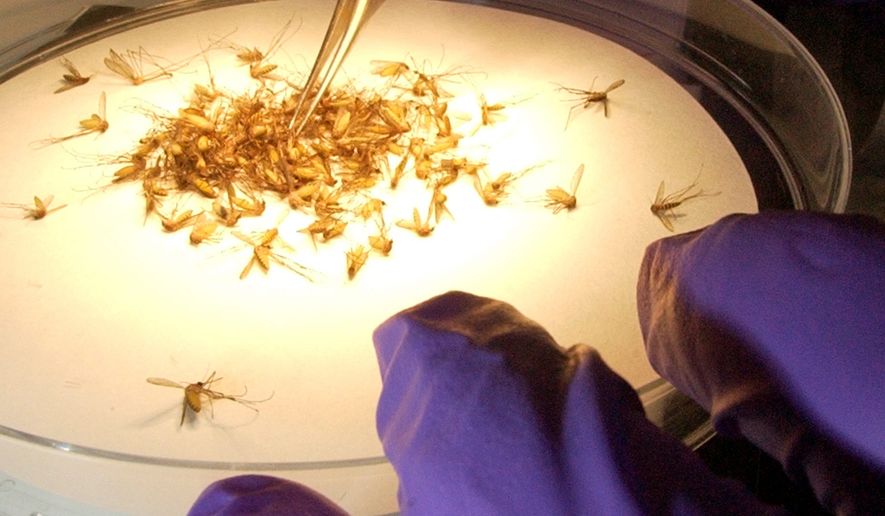Health officials are touting a new protection against bloodsucking insects amid reports of a rare mosquito-borne disease that has infected four people in Massachusetts, killing one woman.
Researchers conducting a study funded by the National Institute of Environmental Health Sciences discovered that a film made of graphene, an element found in charcoal and graphite, showed promise in blocking mosquito bites.
Dry graphene film appeared to interfere with mosquitoes’ ability to detect skin and sweat, according to the study by the Brown University Superfund Research Center.
Mosquitoes landed much less frequently on graphene than on bare skin, researchers noticed. Graphene also provided a strong barrier the insects could not bite through.
When wet, however, graphene did not stop mosquitoes from landing on skin.
“These findings could lead to new protective methods against mosquitoes, without the environmental or human health effects of other chemical-based repellents,” said Heather Henry, a health scientist administrator with the NIEHS Superfund Research Program.
The findings follow Sunday’s death of a Massachusetts woman, the fourth person in the state that became infected with Eastern equine encephalitis (EEE), a rare cause of brain infections spread by mosquitoes.
Confirmed cases of EEE also have been reported in North Carolina and New Jersey. Michigan’s health department has reported three suspected cases of EEE.
Two discoveries of EEE in mosquitoes in Rhode Island motivated the state health department to recommend Monday that schools and municipal leaders schedule sports practices and other outdoor activities either during early morning or dusk hours or earlier in the afternoon to minimize risk of mosquito bites. The health department also suggested relocating activities to indoor venues.
Only a few EEE cases are reported in the United States each year, with most occurring in Eastern or Gulf Coast states, according to the Centers for Disease Control and Prevention.
An average of seven human cases of EEE are reported each year to the CDC. About 30% of people with EEE die and many survivors have ongoing neurologic problems.
“Mosquitoes transmit a wide variety of disease-causing pathogens to humans. Many of these diseases have no treatment available, and the only way to avoid contracting them is to avoid being bit by the mosquitoes that carry the pathogens,” said Jason Rasgon, professor of disease epidemiology for Pennsylvania State University.
He said that mosquito-related infections, including Zika and West Nile virus, are generally lower this year than in previous years and that the number of EEE cases is in line with numbers over the last decade, which range from four to a high of 15 cases in 2012.
For this year, the CDC has reported 206 cases of West Nile virus, compared to 2,647 cases last year. There have been five Zika cases reported in U.S. states this year. Last year, states reported 74 cases.
“Obviously, it is only August, and 2019 isn’t over yet, but it seems that mosquito-borne infections are not as high this year compared to previous years,” Dr. Rasgon said.
Janet C. McAllister, research entomologist for the CDC, said mosquito-related diseases come in cycles, commenting on how health researchers are not sure why or what sets up a particular year to have more cases of a disease or not.
“These diseases are very, very complex because they are not actually a human disease, but a bird disease,” she said, noting that researchers don’t understand what drives the cycle between birds and mosquitoes. To protect against mosquito bites, she suggests covering exposed skin, using EPA-registered repellent, getting rid of standing water around residences, and dumping water from bird baths and scrubbing them to get rid of mosquito eggs.
Joseph Conlon, technical adviser for the American Mosquito Control Association, recommends avoiding going outside during dawn and dusk (when mosquitoes are most active); wearing light colored, loose-fitting clothing; placing floor fans on a deck and porch; ensuring door and window screens fit tightly; and keeping grass and shrubbery well trimmed around the house.
Outside of the U.S., it has been an unusually bad year for dengue, particularly in Central America, South America, the Caribbean, India, some of the Pacific Islands, and parts of Southeast Asia, said Grayson Brown, executive director of the Puerto Rico Vector Control Unit.
“Travelers to these regions should take extra precautions to avoid that disease,” Mr. Brown said.
He noted there is a tendency to defund vector control programs in between disease outbreaks, urging agencies to stick to a vector management strategy instead of letting it deteriorate. He also called for more adoption of novel control approaches since mosquitoes are becoming increasingly resistant to insecticides.
• Shen Wu Tan can be reached at stan@washingtontimes.com.




Please read our comment policy before commenting.